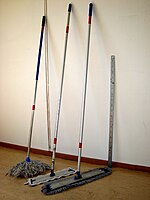| Revision as of 07:47, 2 August 2020 editSerols (talk | contribs)Extended confirmed users, Pending changes reviewers477,454 editsm Reverted edits by 118.148.85.171 (talk) (HG) (3.4.10)Tag: Rollback← Previous edit | Revision as of 07:49, 2 August 2020 edit undo118.148.85.171 (talk) RfaTags: references removed Visual edit Mobile edit Mobile web editNext edit → | ||
| Line 13: | Line 13: | ||
| Professional dry mops consist of a flat sheet of ] textile or sheets with a surface of looped yarn, usually about {{Convert|15|cm|0|abbr = on}} wide, and comes in variable lengths (usually {{Convert|30|-|100|cm|0|abbr = on}}). | Professional dry mops consist of a flat sheet of ] textile or sheets with a surface of looped yarn, usually about {{Convert|15|cm|0|abbr = on}} wide, and comes in variable lengths (usually {{Convert|30|-|100|cm|0|abbr = on}}). | ||
| The dry mop can in many instances replace a broom and has the ability to hold a limited amount of dust or sand within itself. The heads of dry mops are often removable and can be washed and replaced when saturated with dust. |
The dry mop can in many instances replace a broom and has the ability to hold a limited amount of dust or sand within itself. The heads of dry mops are often removable and can be washed and replaced when saturated with dust. Another option is using a vacuum cleaner to suck surface dust away from the mop; however, this is much more limited in its effectiveness. | ||
| Single-use dry mops are also available and widely sold. | Single-use dry mops are also available and widely sold. | ||
| Line 19: | Line 19: | ||
| ===Wet-mop, moist-mop=== | ===Wet-mop, moist-mop=== | ||
| A '''wet mop''' or '''moist mop''' is, in professional cleaning, used as in the second step in the cleaning of a surface. The wet mop is swept over the surface to dissolve and absorb fat, mud and dried-in liquid contaminations. Professional wet mops consist of a flat sheet of microfiber textile or a sheet with a surface of looped yarn (which might contain microfiber as well), usually about {{Convert|15|cm|0|abbr = on}} wide, and come in various lengths (usually {{Convert|30|-|100|cm|0|abbr = on}}). | A '''wet mop''' or '''moist mop''' is, in professional cleaning, used as in the second step in the cleaning of a surface. The wet mop is swept over the surface to dissolve and absorb fat, mud and dried-in liquid contaminations. Professional wet mops consist of a flat sheet of microfiber textile or a sheet with a surface of looped yarn (which might contain microfiber as well), usually about {{Convert|15|cm|0|abbr = on}} wide, and come in various lengths (usually {{Convert|30|-|100|cm|0|abbr = on}}). | ||
| <gallery widths="75px" heights="200px"> | |||
| File:Mop for wet use, looped microfiber, velcro back, 60 cm.jpg|Flat wet-mop (pre-moisting). ] microfiber with Velcro mounting on back. | |||
| File:Mop for wet use, looped microfiber, velcro back, 60 cm (back view).jpg|Flat wet-mop (back view of previous mop). | |||
| File:Mop for wet or dry use, open end microfiber, looped yarn edge, velcro back, 60 cm.jpg|Flat mop for dry or wet (pre-moisting) use. Open-end microfiber with looped yarn edges. Velcro back. | |||
| </gallery> | |||
| ===Mops for pre-moisting=== | ===Mops for pre-moisting=== | ||
Revision as of 07:49, 2 August 2020
For other uses, see MOP (disambiguation) and Mops (disambiguation).

A mop (such as a floor mop) is a mass or bundle of coarse strings or yarn, etc., or a piece of cloth, sponge or other absorbent material, attached to a pole or stick. It is used to soak up liquid, for cleaning floors and other surfaces, to mop up dust, or for other cleaning purposes. The word (then spelled mappe) is attested in English as early as 1496, but new refinements and variations of mop designs have been introduced, from time to time. For example, American inventor Jacob Howe received U.S. patent #241 for a mop holder in 1837 and Thomas W. Stewart (U.S. patent #499,402) in 1893. At the 1968 Miss America protest, protestors symbolically threw a number of feminine products into a "Freedom Trash Can", which included mops.
Types
| This section needs additional citations for verification. Please help improve this article by adding citations to reliable sources in this section. Unsourced material may be challenged and removed. (August 2016) (Learn how and when to remove this message) |

Dry mop, dust mop
A dry mop or dust mop is designed to pick up dry, loose contamination such as dust, earth, and sand from the surface of the floor. It consists of yarn and/or microfiber and can be used as a first step in cleaning a floor.
Professional dry mops consist of a flat sheet of microfiber textile or sheets with a surface of looped yarn, usually about 15 cm (6 in) wide, and comes in variable lengths (usually 30–100 cm (12–39 in)).
The dry mop can in many instances replace a broom and has the ability to hold a limited amount of dust or sand within itself. The heads of dry mops are often removable and can be washed and replaced when saturated with dust. Another option is using a vacuum cleaner to suck surface dust away from the mop; however, this is much more limited in its effectiveness.
Single-use dry mops are also available and widely sold.
Wet-mop, moist-mop
A wet mop or moist mop is, in professional cleaning, used as in the second step in the cleaning of a surface. The wet mop is swept over the surface to dissolve and absorb fat, mud and dried-in liquid contaminations. Professional wet mops consist of a flat sheet of microfiber textile or a sheet with a surface of looped yarn (which might contain microfiber as well), usually about 15 cm (6 in) wide, and come in various lengths (usually 30–100 cm (12–39 in)).
Mops for pre-moisting

Professional flat mops are made for pre-moisting. Mops are pre-impregnated with an ideal amount of water mixed with an appropriate amount of detergent. This means that the cleaner does not need to bring any additional water on the cleaning trolley. This ideal amount is often recommended by the manufacturer in terms of weight percent of water per weight of the dry mop, for example "175% water per weight of the dry mop".
Mops for pre-moisting are flat sheets of (often microfiber) textile, usually about 15 cm (6 in) wide, and comes in variable lengths (usually 30–100 cm (12–39 in)). Mops for pre-moisting are fastened on a handle with a flat pad mount with the aid of velcro or a pouch on the mop, in which the pad on the handle fits.
Pre-moisting can be done with a special washing machine or by hand by simply folding and packing the mops tight in a container and pouring the measured amount of water over them. The mops will then need about 5–10 minutes for the liquid to distribute evenly in their tissue before use. This offers some advantages:
- The cleaner does not have to have a bucket of water with him/her when sweeping the floor, but simply carries an appropriate number of mops. This means the weight of the equipment can often be kept lower.
- The risk of over-wetting the floor and leave puddles is eliminated if the wetness is ideal.
Hot mop
The hot mop (or steam mop) follows a similar concept to a steam iron. After adding water, the water is heated to make it exude on top of a floor, which can then be cleaned without using a cleaning solvent. These can work best on surfaces where a regular mop would also be used, such as bare floors, hearths, and laminate.
Syntho-mop
A syntho-mop such as the Scooba is not considered a mop, because even though it performs the same function as a traditional mop, the lack of hand operation makes it ineligible for status as a mop.
Microfiber mop
Microfiber mops are constructed of a blend of polyester and polyamide fibers which are “split” and formed into a single fiber. This blend consists of 70-90% polyester that serves as the scrubbing and cleaning fiber and 10–30% polyamide which performs as the holding and quick drying fiber. This blend is usually expressed as a ratio on the label of the mop, e.g. an 80% polyester and 20% polyamide blend would be labeled as "80/20".
Handles and mounting
A mop handle consists of a long piece of wood or aluminium tubing fitted with a specific mount for the mop. The handle can be attached for mounting a mop on it by means of:
- clamp
- hanger (with strands doubled over the hanger)
- plastic claws (attached to the strands)
- pouch (as with many professional flat mops)
- screwing (as with the classic yarn mop)
- velcro (as with many professional flat mops)
Image gallery
-
 Mop handles From left: Classic yarn mop handle made of aluminium (thread mount), unadjustable aluminium handle for velcro mop (50 cm), unadjustable aluminium handle for velcro mop (60 cm), scale included for reference.
Mop handles From left: Classic yarn mop handle made of aluminium (thread mount), unadjustable aluminium handle for velcro mop (50 cm), unadjustable aluminium handle for velcro mop (60 cm), scale included for reference.
-
 Detail of mop mounting piece (blue plastic) and mount
Detail of mop mounting piece (blue plastic) and mount
-
Velcro mop with mount
-
 Xiaomi Deerma spray mop
Xiaomi Deerma spray mop
Traditional construction
In her book Maggie's Memories Margaret Wadkin (late of Hickling, near Melton Mowbray in England) describes the use of a mop nail for constructing homemade mops from old pieces of cloth during her village childhood in the early 20th century. "The mop nail was made by the blacksmith (if there are any still around, they will be antiques). This nail was several inches long with a point at the end and a flat head a couple or so inches wide. We would stand the nail on its flat head, cut pieces of old material into squares and push over the sharp end of the nail and when enough fix a piece of leather, then push the sharp point into the mop stale or handle. There was a knack of twisting these mops over the wrist to swish away surplus water, every woman could use one of these useful mops."
See also
References
- "Mop - Definition of mop by Merriam-Webster". merriam-webster.com.
- U.S. patent 241
- U.S. patent 499,402
- Greenfieldboyce, Nell (September 5, 2008). "Pageant Protest Sparked Bra-Burning Myth". National Public Radio. Retrieved 6 February 2012.
- Maggie's Memories: Childhood Memories of Hickling. Privately published memoirs.
External links
 Media related to Mops at Wikimedia Commons
Media related to Mops at Wikimedia Commons
| Cleaning tools (List) | |
|---|---|